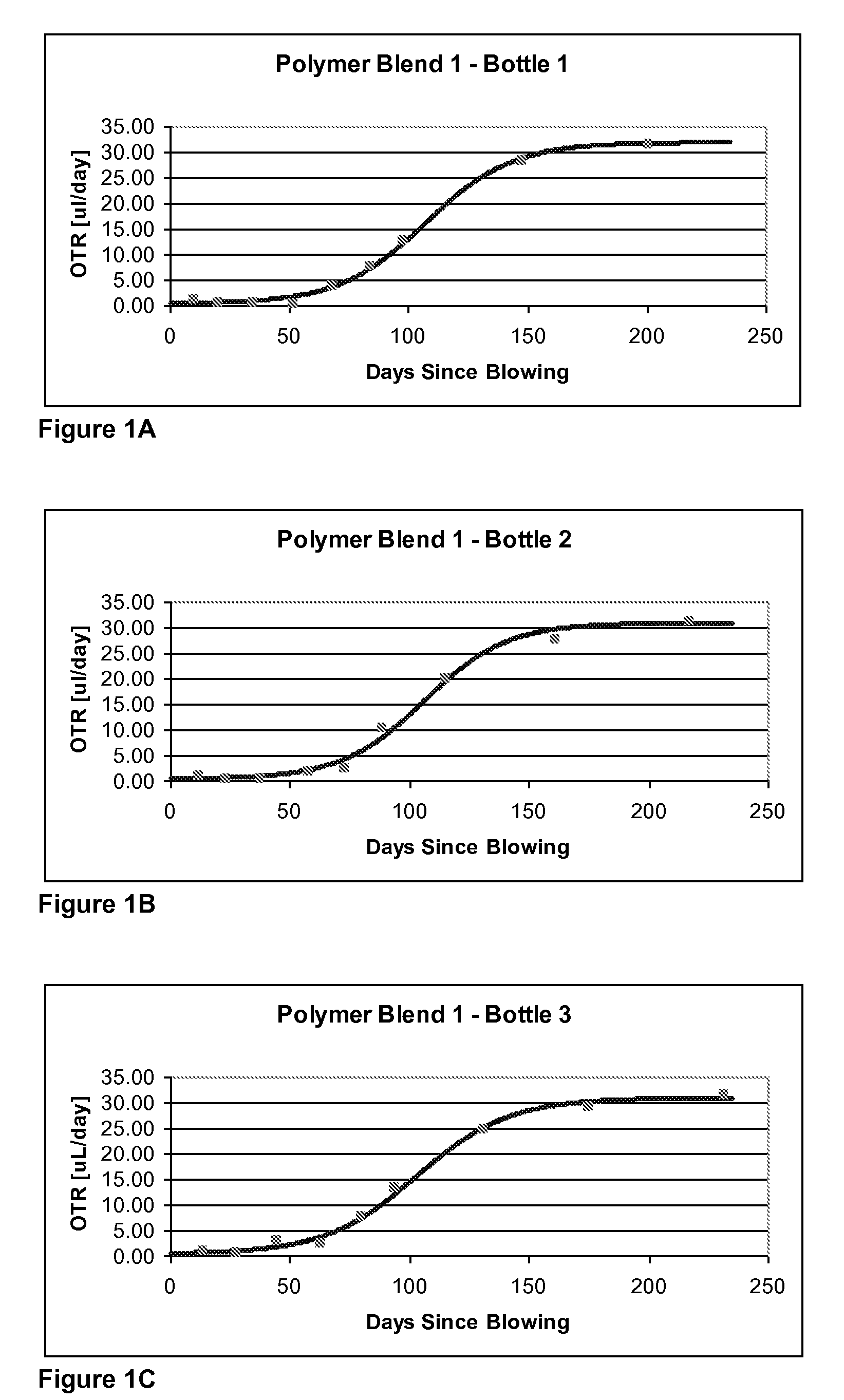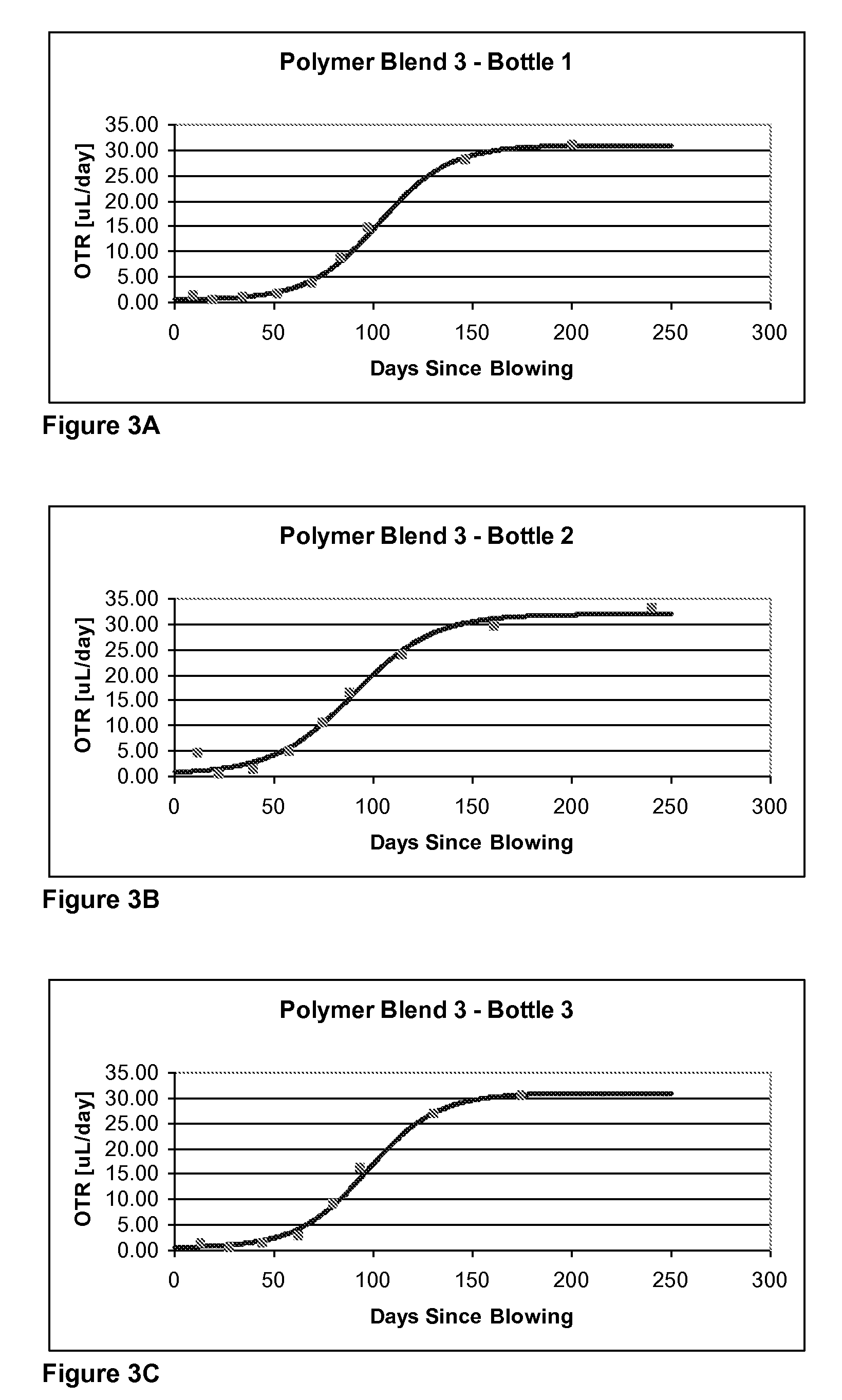Oxygen-scavenging polymer blends suitable for use in packaging
a technology of oxygen-scavenging polymers and polymers, which is applied in the field of polymer blends, can solve the problems that the oxygen barrier properties of such polymers do not provide adequate protection for the produ
- Summary
- Abstract
- Description
- Claims
- Application Information
AI Technical Summary
Benefits of technology
Problems solved by technology
Method used
Image
Examples
example 1
[0224]In this example, thirteen polymer blends (Polymer Blends 1-13) were prepared as described below. Polymer Blends-1 through -13 were prepared using copolyesters PET-1 through PET-13, respectively.
[0225]PET-1 through PET-10 were polyester copolymers containing residues of terephthalic acid, ethylene glycol, and isophthalic acid, with isophthalic acid residues representing about 2.9 mole % of the dicarboxylic acid residues. Each of copolyesters PET-1 through PET-10 were prepared by means of a melt-phase-only polymerization process using a Li / Al / P catalyst system comprising about 10 to about 17 ppm Al, about 8 to about 13 ppm Li, and up to about 111 ppm phosphorus. The melt-phase-only PET polymers PET-1 through PET-10 were prepared by melt polymerizing the dicarboxylic acids and diol residues in the presence of the aluminum and lithium catalysts, reheat additive, and toners to the intrinsic viscosities as set forth in Table 1, after which phosphorus was added to the molten PET poly...
example 2
[0261]Polymer Blends 14-19 were prepared using melt-phase-only PET polymers PET-14 through PET 19, respectively, comprising a Li / Al / P catalyst system as described for Polymer Blend-1 of Example 1. Polymer Blends 20, 21, and 22 were each prepared as controls and comprised PET-11, -12, and -13, respectively, as described in Example 1.
[0262]PET-14 through PET-19 were PET copolymers containing residues of terephthalic acid, ethylene glycol, and isophthalic acid, with isophthalic acid residues representing about 2.9 mole % of the dicarboxylic acid residues. Each of copolyesters PET-1 through PET-10 were prepared by means of a melt-phase-only PET polymerization process using a Li / Al / P catalyst system comprising about 9 to about 14 ppm Li, about 11 to about 19 ppm Al, and about 22 to about 70 ppm phosphorus. The melt-phase-only PET polymers PET-14 through PET-19 were prepared by melt polymerizing the dicarboxylic acids and diol residues in the presence of the aluminum and lithium catalysts...
PUM
| Property | Measurement | Unit |
|---|---|---|
| Fraction | aaaaa | aaaaa |
| Fraction | aaaaa | aaaaa |
| Fraction | aaaaa | aaaaa |
Abstract
Description
Claims
Application Information
 Login to View More
Login to View More - R&D
- Intellectual Property
- Life Sciences
- Materials
- Tech Scout
- Unparalleled Data Quality
- Higher Quality Content
- 60% Fewer Hallucinations
Browse by: Latest US Patents, China's latest patents, Technical Efficacy Thesaurus, Application Domain, Technology Topic, Popular Technical Reports.
© 2025 PatSnap. All rights reserved.Legal|Privacy policy|Modern Slavery Act Transparency Statement|Sitemap|About US| Contact US: help@patsnap.com



